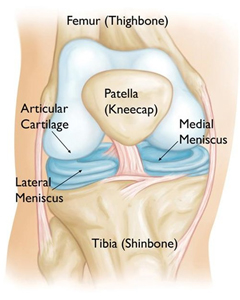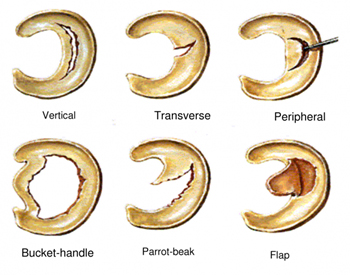What is the meniscus?
Each knee has two menisci – the medial meniscus and the lateral meniscus. Each meniscus is a wedge shaped semi-circular pad made of fibro-cartilage. They act as the shock absorbers of the knee, between the femur (thigh) bone and tibia (shin) bone.


How does it tear?
Meniscal tears typically occur through twisting, loading or direct trauma to the knee. These are deemed acute tears. Tears can also occur through “wear and tear” over time, which are called degenerative tears. A combination of the two can also occur.
What are the types of meniscal tears?
Tears can be described by how recently they occurred, the shape of the tear, and the location of the tear within the meniscus itself. Some shapes of tear that patients may have include radial, horizontal cleavage, parrot-beak and bucket handle tears. The location of the tear can be towards the inner edge of the meniscus where the blood supply is less, or towards the outer edge near the knee capsule where the blood supply is better. Tears can also occur at the meniscal root, where the meniscus attaches to bone.

What problems can a Meniscal Tear cause?
A pop may be felt when the meniscus tears acutely. People can usually still walk after the tear. Common symptoms include pain, swelling, stiffness, mechanical symptoms of clicking and catching, a feeling of giving way or the knee locking in position.
What is a locked knee?
When certain structures in your knee are injured, they can move out of their normal position. The displaced fragment can then get stuck and stop the knee from fully straightening; this is called a locked knee. Common causes of a locked knee include a displaced bucket handle tear of the meniscus, as well as displaced chondral or osteochondral fragments.
How is a meniscal tear treated?
The treatment of a meniscal tear depends on multiple factors, as outlined above: the type of tear you have, its size, its location as well as your age and personal requirements. The presence of other conditions (such as an ACL rupture or osteoarthritis) will also be taken in to consideration. The majority of meniscal tears are initially treated non-operatively with RICE and range of motion exercises through physiotherapy to strengthen your knee muscles.
A locked knee is an indication for meniscal surgery. A failure of non-operative management to control the symptoms of recurrent pain, swelling and mechanical catching and locking is also a reason to consider meniscal surgery. Your surgeon at Melbourne Hip and Knee will take all of the above into account when discussing the treatment options with you. Meniscal surgery can broadly be divided into Meniscal debridement or Meniscal repair.

